Business Law Report: Legal Systems, Business Problems and Solutions
VerifiedAdded on 2020/10/22
|9
|3323
|288
Report
AI Summary
This business law report delves into the intricacies of the English legal system and its impact on businesses, particularly startups. It examines the sources of law, differentiating between statutory and common law, and their application in court. The report analyzes the impact of employment and contract law on business operations, emphasizing the importance of contract principles and the legal status of workers. It also addresses common business problems, such as financial management and compliance, offering solutions for a sole trader considering incorporation as a limited company, and justifies appropriate legal solutions. Finally, the report explores alternative dispute resolution methods for resolving business conflicts, providing a comprehensive overview of business law principles and practices.
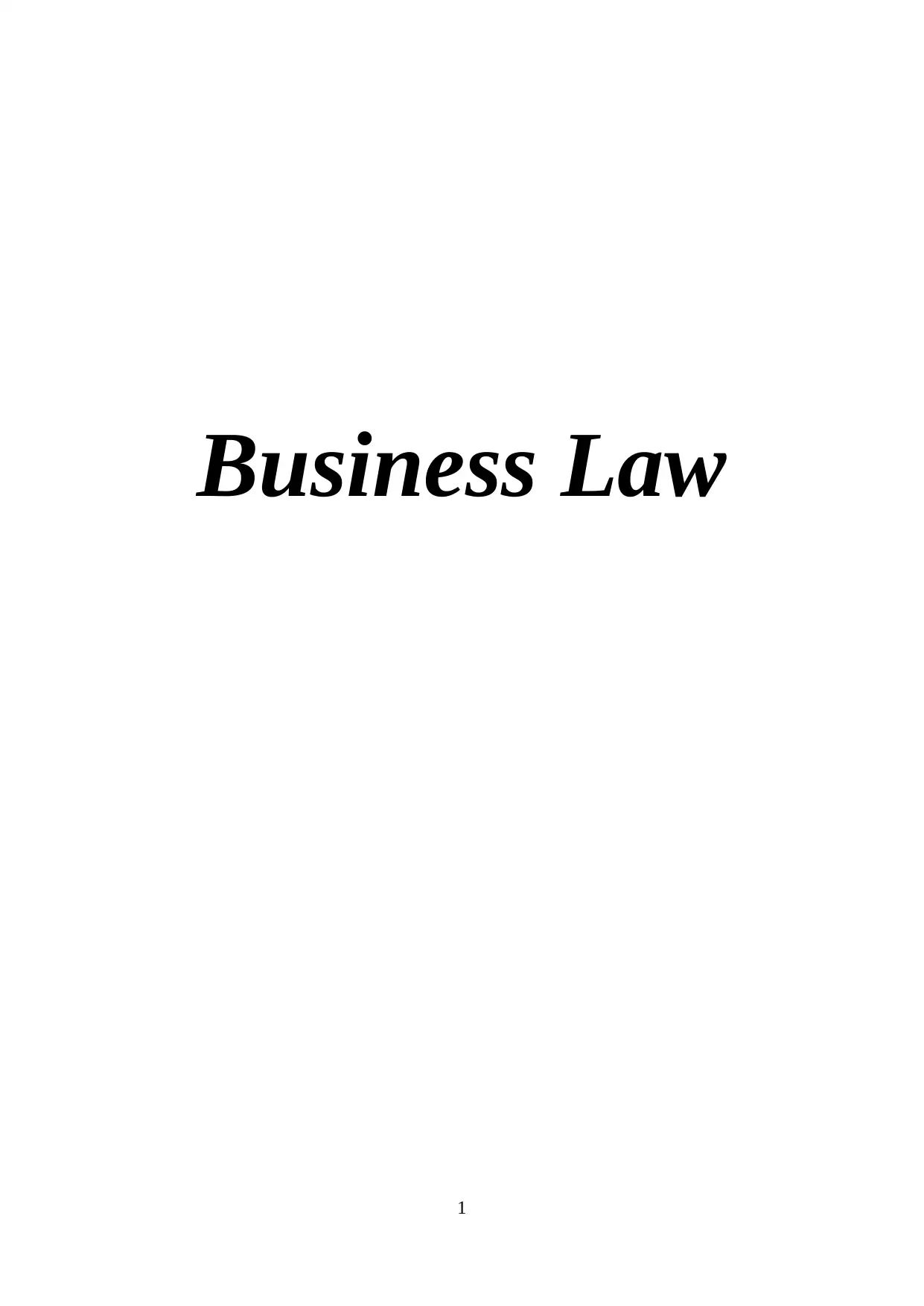
Business Law
1
1
Paraphrase This Document
Need a fresh take? Get an instant paraphrase of this document with our AI Paraphraser
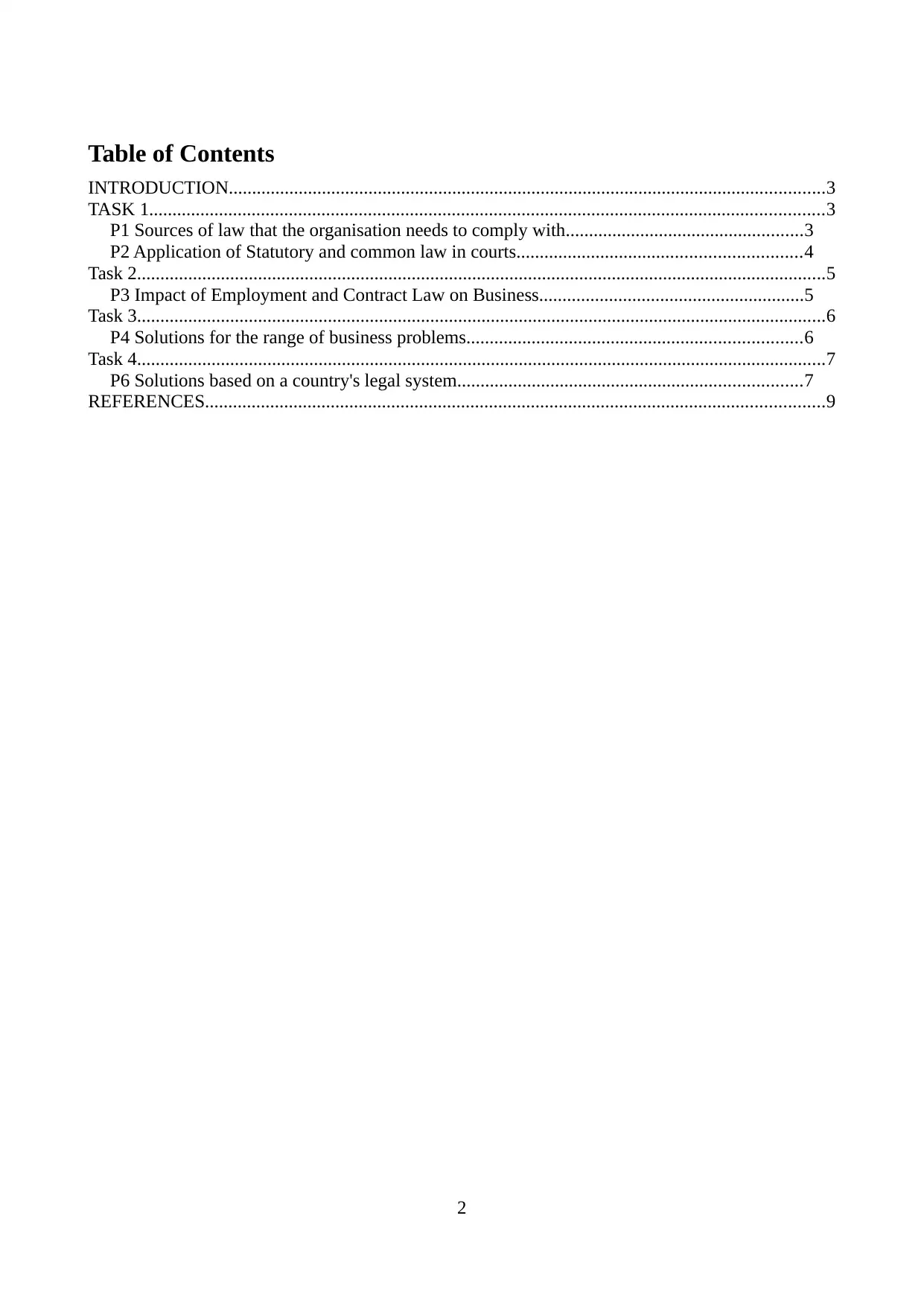
Table of Contents
INTRODUCTION................................................................................................................................3
TASK 1.................................................................................................................................................3
P1 Sources of law that the organisation needs to comply with...................................................3
P2 Application of Statutory and common law in courts.............................................................4
Task 2....................................................................................................................................................5
P3 Impact of Employment and Contract Law on Business.........................................................5
Task 3....................................................................................................................................................6
P4 Solutions for the range of business problems........................................................................6
Task 4....................................................................................................................................................7
P6 Solutions based on a country's legal system..........................................................................7
REFERENCES.....................................................................................................................................9
2
INTRODUCTION................................................................................................................................3
TASK 1.................................................................................................................................................3
P1 Sources of law that the organisation needs to comply with...................................................3
P2 Application of Statutory and common law in courts.............................................................4
Task 2....................................................................................................................................................5
P3 Impact of Employment and Contract Law on Business.........................................................5
Task 3....................................................................................................................................................6
P4 Solutions for the range of business problems........................................................................6
Task 4....................................................................................................................................................7
P6 Solutions based on a country's legal system..........................................................................7
REFERENCES.....................................................................................................................................9
2
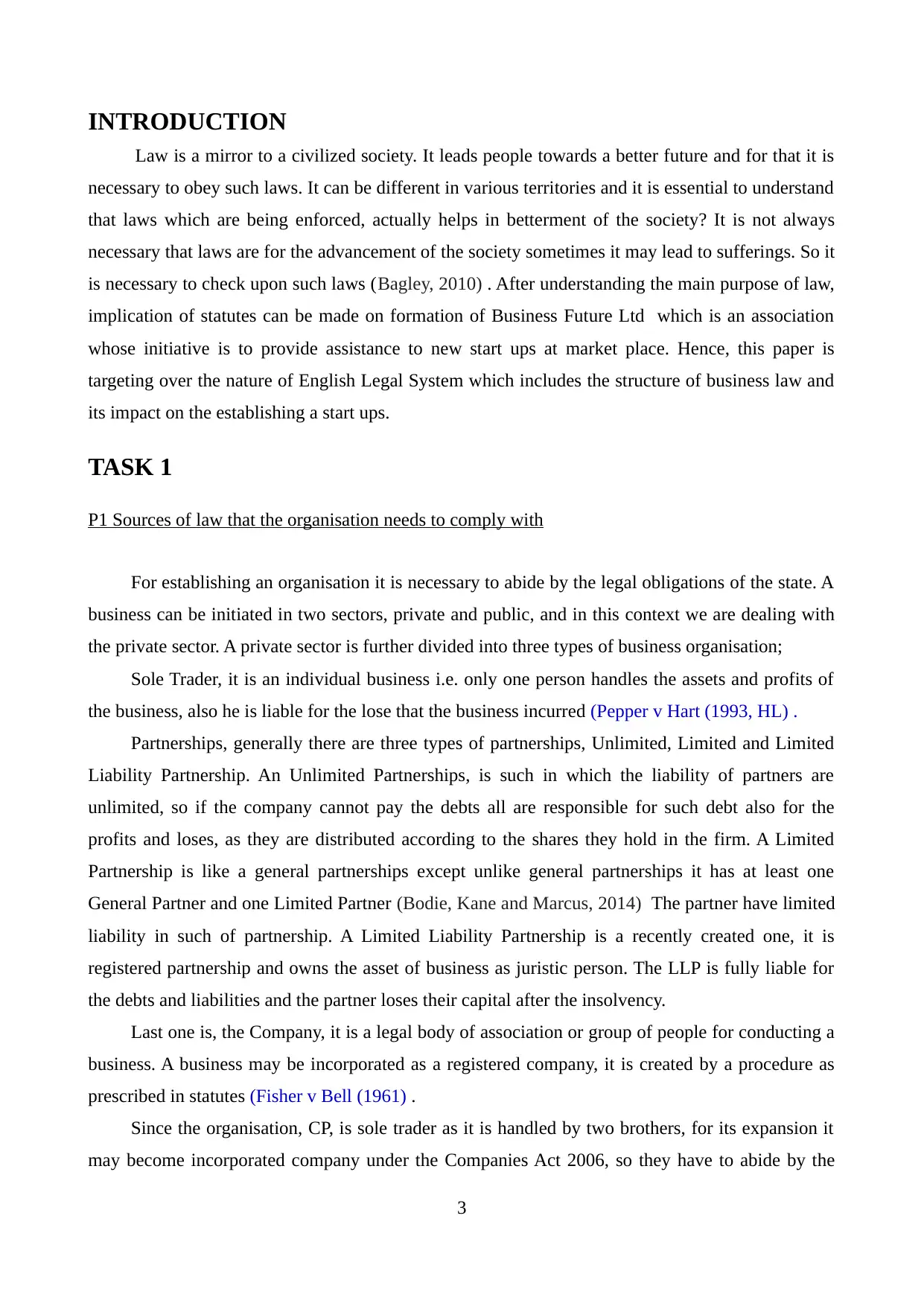
INTRODUCTION
Law is a mirror to a civilized society. It leads people towards a better future and for that it is
necessary to obey such laws. It can be different in various territories and it is essential to understand
that laws which are being enforced, actually helps in betterment of the society? It is not always
necessary that laws are for the advancement of the society sometimes it may lead to sufferings. So it
is necessary to check upon such laws (Bagley, 2010) . After understanding the main purpose of law,
implication of statutes can be made on formation of Business Future Ltd which is an association
whose initiative is to provide assistance to new start ups at market place. Hence, this paper is
targeting over the nature of English Legal System which includes the structure of business law and
its impact on the establishing a start ups.
TASK 1
P1 Sources of law that the organisation needs to comply with
For establishing an organisation it is necessary to abide by the legal obligations of the state. A
business can be initiated in two sectors, private and public, and in this context we are dealing with
the private sector. A private sector is further divided into three types of business organisation;
Sole Trader, it is an individual business i.e. only one person handles the assets and profits of
the business, also he is liable for the lose that the business incurred (Pepper v Hart (1993, HL) .
Partnerships, generally there are three types of partnerships, Unlimited, Limited and Limited
Liability Partnership. An Unlimited Partnerships, is such in which the liability of partners are
unlimited, so if the company cannot pay the debts all are responsible for such debt also for the
profits and loses, as they are distributed according to the shares they hold in the firm. A Limited
Partnership is like a general partnerships except unlike general partnerships it has at least one
General Partner and one Limited Partner (Bodie, Kane and Marcus, 2014) The partner have limited
liability in such of partnership. A Limited Liability Partnership is a recently created one, it is
registered partnership and owns the asset of business as juristic person. The LLP is fully liable for
the debts and liabilities and the partner loses their capital after the insolvency.
Last one is, the Company, it is a legal body of association or group of people for conducting a
business. A business may be incorporated as a registered company, it is created by a procedure as
prescribed in statutes (Fisher v Bell (1961) .
Since the organisation, CP, is sole trader as it is handled by two brothers, for its expansion it
may become incorporated company under the Companies Act 2006, so they have to abide by the
3
Law is a mirror to a civilized society. It leads people towards a better future and for that it is
necessary to obey such laws. It can be different in various territories and it is essential to understand
that laws which are being enforced, actually helps in betterment of the society? It is not always
necessary that laws are for the advancement of the society sometimes it may lead to sufferings. So it
is necessary to check upon such laws (Bagley, 2010) . After understanding the main purpose of law,
implication of statutes can be made on formation of Business Future Ltd which is an association
whose initiative is to provide assistance to new start ups at market place. Hence, this paper is
targeting over the nature of English Legal System which includes the structure of business law and
its impact on the establishing a start ups.
TASK 1
P1 Sources of law that the organisation needs to comply with
For establishing an organisation it is necessary to abide by the legal obligations of the state. A
business can be initiated in two sectors, private and public, and in this context we are dealing with
the private sector. A private sector is further divided into three types of business organisation;
Sole Trader, it is an individual business i.e. only one person handles the assets and profits of
the business, also he is liable for the lose that the business incurred (Pepper v Hart (1993, HL) .
Partnerships, generally there are three types of partnerships, Unlimited, Limited and Limited
Liability Partnership. An Unlimited Partnerships, is such in which the liability of partners are
unlimited, so if the company cannot pay the debts all are responsible for such debt also for the
profits and loses, as they are distributed according to the shares they hold in the firm. A Limited
Partnership is like a general partnerships except unlike general partnerships it has at least one
General Partner and one Limited Partner (Bodie, Kane and Marcus, 2014) The partner have limited
liability in such of partnership. A Limited Liability Partnership is a recently created one, it is
registered partnership and owns the asset of business as juristic person. The LLP is fully liable for
the debts and liabilities and the partner loses their capital after the insolvency.
Last one is, the Company, it is a legal body of association or group of people for conducting a
business. A business may be incorporated as a registered company, it is created by a procedure as
prescribed in statutes (Fisher v Bell (1961) .
Since the organisation, CP, is sole trader as it is handled by two brothers, for its expansion it
may become incorporated company under the Companies Act 2006, so they have to abide by the
3
⊘ This is a preview!⊘
Do you want full access?
Subscribe today to unlock all pages.

Trusted by 1+ million students worldwide
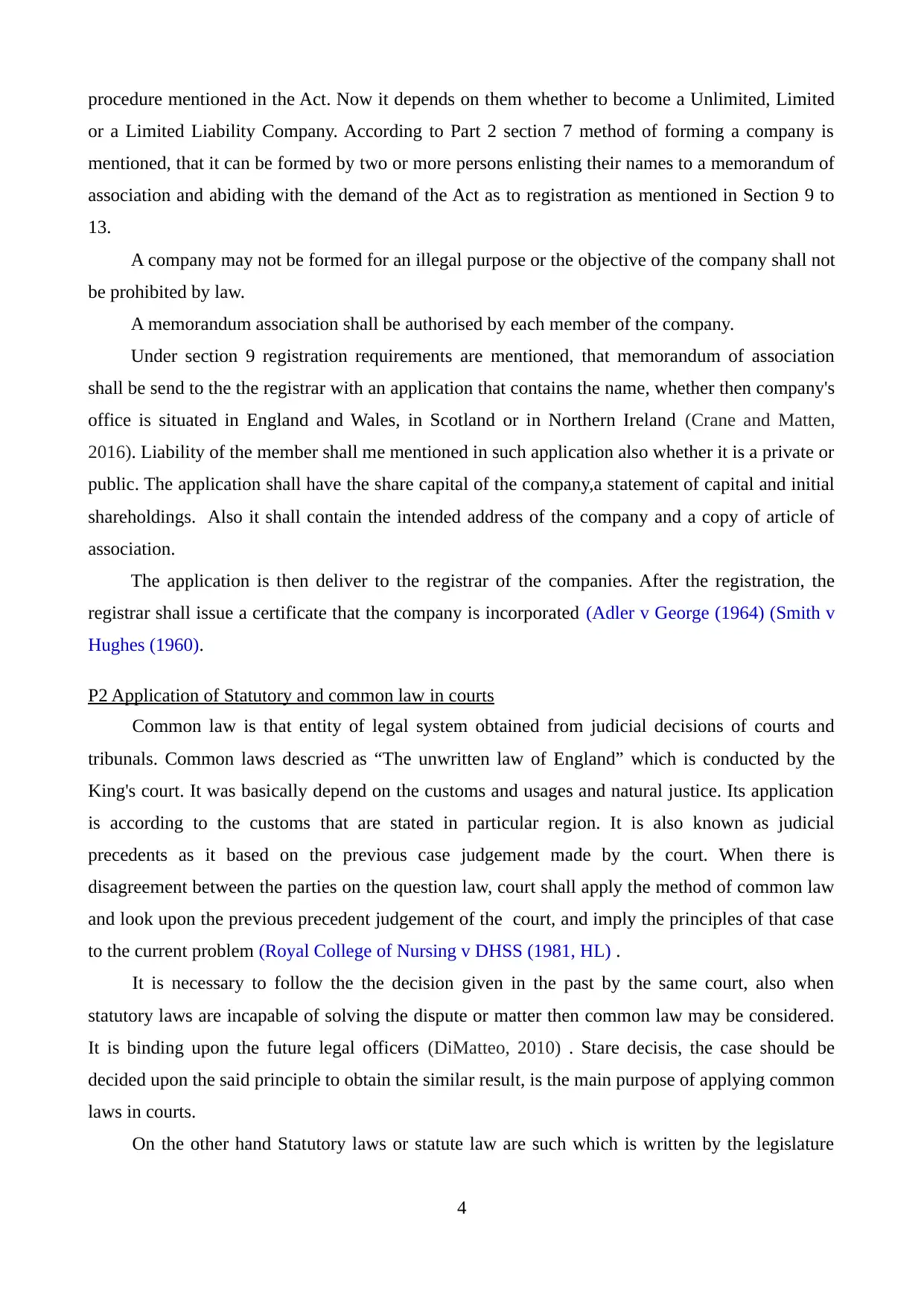
procedure mentioned in the Act. Now it depends on them whether to become a Unlimited, Limited
or a Limited Liability Company. According to Part 2 section 7 method of forming a company is
mentioned, that it can be formed by two or more persons enlisting their names to a memorandum of
association and abiding with the demand of the Act as to registration as mentioned in Section 9 to
13.
A company may not be formed for an illegal purpose or the objective of the company shall not
be prohibited by law.
A memorandum association shall be authorised by each member of the company.
Under section 9 registration requirements are mentioned, that memorandum of association
shall be send to the the registrar with an application that contains the name, whether then company's
office is situated in England and Wales, in Scotland or in Northern Ireland (Crane and Matten,
2016). Liability of the member shall me mentioned in such application also whether it is a private or
public. The application shall have the share capital of the company,a statement of capital and initial
shareholdings. Also it shall contain the intended address of the company and a copy of article of
association.
The application is then deliver to the registrar of the companies. After the registration, the
registrar shall issue a certificate that the company is incorporated (Adler v George (1964) (Smith v
Hughes (1960).
P2 Application of Statutory and common law in courts
Common law is that entity of legal system obtained from judicial decisions of courts and
tribunals. Common laws descried as “The unwritten law of England” which is conducted by the
King's court. It was basically depend on the customs and usages and natural justice. Its application
is according to the customs that are stated in particular region. It is also known as judicial
precedents as it based on the previous case judgement made by the court. When there is
disagreement between the parties on the question law, court shall apply the method of common law
and look upon the previous precedent judgement of the court, and imply the principles of that case
to the current problem (Royal College of Nursing v DHSS (1981, HL) .
It is necessary to follow the the decision given in the past by the same court, also when
statutory laws are incapable of solving the dispute or matter then common law may be considered.
It is binding upon the future legal officers (DiMatteo, 2010) . Stare decisis, the case should be
decided upon the said principle to obtain the similar result, is the main purpose of applying common
laws in courts.
On the other hand Statutory laws or statute law are such which is written by the legislature
4
or a Limited Liability Company. According to Part 2 section 7 method of forming a company is
mentioned, that it can be formed by two or more persons enlisting their names to a memorandum of
association and abiding with the demand of the Act as to registration as mentioned in Section 9 to
13.
A company may not be formed for an illegal purpose or the objective of the company shall not
be prohibited by law.
A memorandum association shall be authorised by each member of the company.
Under section 9 registration requirements are mentioned, that memorandum of association
shall be send to the the registrar with an application that contains the name, whether then company's
office is situated in England and Wales, in Scotland or in Northern Ireland (Crane and Matten,
2016). Liability of the member shall me mentioned in such application also whether it is a private or
public. The application shall have the share capital of the company,a statement of capital and initial
shareholdings. Also it shall contain the intended address of the company and a copy of article of
association.
The application is then deliver to the registrar of the companies. After the registration, the
registrar shall issue a certificate that the company is incorporated (Adler v George (1964) (Smith v
Hughes (1960).
P2 Application of Statutory and common law in courts
Common law is that entity of legal system obtained from judicial decisions of courts and
tribunals. Common laws descried as “The unwritten law of England” which is conducted by the
King's court. It was basically depend on the customs and usages and natural justice. Its application
is according to the customs that are stated in particular region. It is also known as judicial
precedents as it based on the previous case judgement made by the court. When there is
disagreement between the parties on the question law, court shall apply the method of common law
and look upon the previous precedent judgement of the court, and imply the principles of that case
to the current problem (Royal College of Nursing v DHSS (1981, HL) .
It is necessary to follow the the decision given in the past by the same court, also when
statutory laws are incapable of solving the dispute or matter then common law may be considered.
It is binding upon the future legal officers (DiMatteo, 2010) . Stare decisis, the case should be
decided upon the said principle to obtain the similar result, is the main purpose of applying common
laws in courts.
On the other hand Statutory laws or statute law are such which is written by the legislature
4
Paraphrase This Document
Need a fresh take? Get an instant paraphrase of this document with our AI Paraphraser
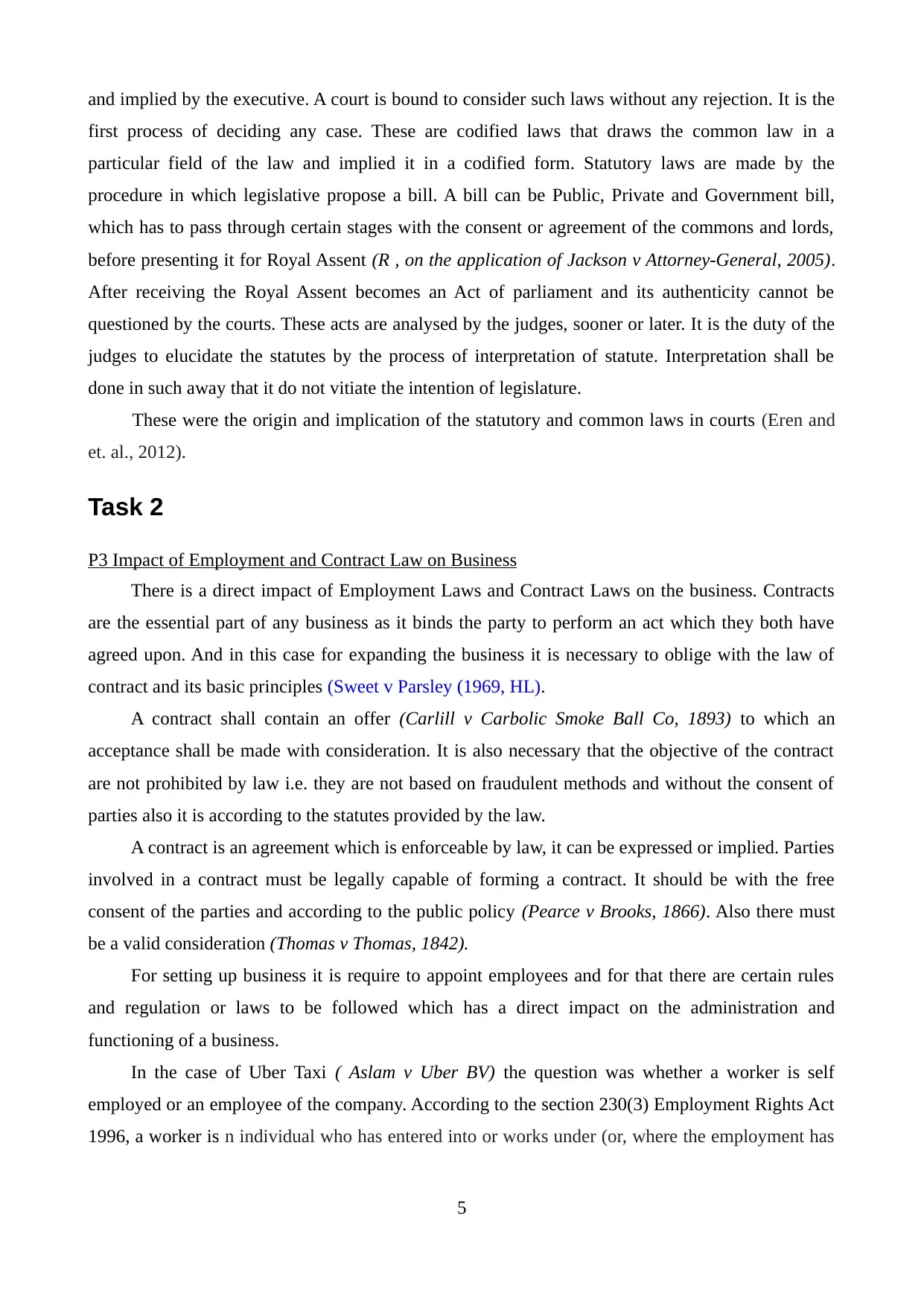
and implied by the executive. A court is bound to consider such laws without any rejection. It is the
first process of deciding any case. These are codified laws that draws the common law in a
particular field of the law and implied it in a codified form. Statutory laws are made by the
procedure in which legislative propose a bill. A bill can be Public, Private and Government bill,
which has to pass through certain stages with the consent or agreement of the commons and lords,
before presenting it for Royal Assent (R , on the application of Jackson v Attorney-General, 2005).
After receiving the Royal Assent becomes an Act of parliament and its authenticity cannot be
questioned by the courts. These acts are analysed by the judges, sooner or later. It is the duty of the
judges to elucidate the statutes by the process of interpretation of statute. Interpretation shall be
done in such away that it do not vitiate the intention of legislature.
These were the origin and implication of the statutory and common laws in courts (Eren and
et. al., 2012).
Task 2
P3 Impact of Employment and Contract Law on Business
There is a direct impact of Employment Laws and Contract Laws on the business. Contracts
are the essential part of any business as it binds the party to perform an act which they both have
agreed upon. And in this case for expanding the business it is necessary to oblige with the law of
contract and its basic principles (Sweet v Parsley (1969, HL).
A contract shall contain an offer (Carlill v Carbolic Smoke Ball Co, 1893) to which an
acceptance shall be made with consideration. It is also necessary that the objective of the contract
are not prohibited by law i.e. they are not based on fraudulent methods and without the consent of
parties also it is according to the statutes provided by the law.
A contract is an agreement which is enforceable by law, it can be expressed or implied. Parties
involved in a contract must be legally capable of forming a contract. It should be with the free
consent of the parties and according to the public policy (Pearce v Brooks, 1866). Also there must
be a valid consideration (Thomas v Thomas, 1842).
For setting up business it is require to appoint employees and for that there are certain rules
and regulation or laws to be followed which has a direct impact on the administration and
functioning of a business.
In the case of Uber Taxi ( Aslam v Uber BV) the question was whether a worker is self
employed or an employee of the company. According to the section 230(3) Employment Rights Act
1996, a worker is n individual who has entered into or works under (or, where the employment has
5
first process of deciding any case. These are codified laws that draws the common law in a
particular field of the law and implied it in a codified form. Statutory laws are made by the
procedure in which legislative propose a bill. A bill can be Public, Private and Government bill,
which has to pass through certain stages with the consent or agreement of the commons and lords,
before presenting it for Royal Assent (R , on the application of Jackson v Attorney-General, 2005).
After receiving the Royal Assent becomes an Act of parliament and its authenticity cannot be
questioned by the courts. These acts are analysed by the judges, sooner or later. It is the duty of the
judges to elucidate the statutes by the process of interpretation of statute. Interpretation shall be
done in such away that it do not vitiate the intention of legislature.
These were the origin and implication of the statutory and common laws in courts (Eren and
et. al., 2012).
Task 2
P3 Impact of Employment and Contract Law on Business
There is a direct impact of Employment Laws and Contract Laws on the business. Contracts
are the essential part of any business as it binds the party to perform an act which they both have
agreed upon. And in this case for expanding the business it is necessary to oblige with the law of
contract and its basic principles (Sweet v Parsley (1969, HL).
A contract shall contain an offer (Carlill v Carbolic Smoke Ball Co, 1893) to which an
acceptance shall be made with consideration. It is also necessary that the objective of the contract
are not prohibited by law i.e. they are not based on fraudulent methods and without the consent of
parties also it is according to the statutes provided by the law.
A contract is an agreement which is enforceable by law, it can be expressed or implied. Parties
involved in a contract must be legally capable of forming a contract. It should be with the free
consent of the parties and according to the public policy (Pearce v Brooks, 1866). Also there must
be a valid consideration (Thomas v Thomas, 1842).
For setting up business it is require to appoint employees and for that there are certain rules
and regulation or laws to be followed which has a direct impact on the administration and
functioning of a business.
In the case of Uber Taxi ( Aslam v Uber BV) the question was whether a worker is self
employed or an employee of the company. According to the section 230(3) Employment Rights Act
1996, a worker is n individual who has entered into or works under (or, where the employment has
5
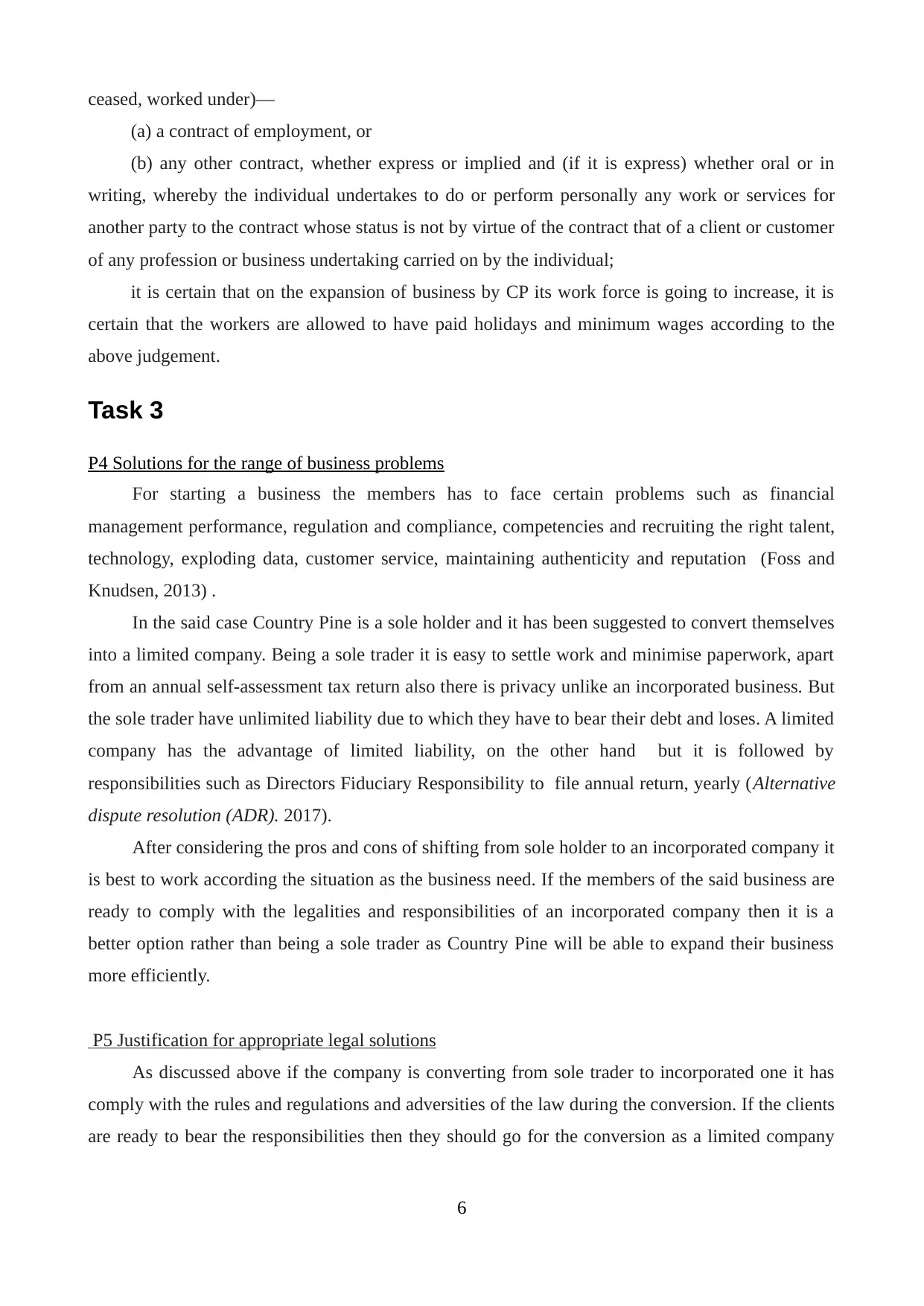
ceased, worked under)—
(a) a contract of employment, or
(b) any other contract, whether express or implied and (if it is express) whether oral or in
writing, whereby the individual undertakes to do or perform personally any work or services for
another party to the contract whose status is not by virtue of the contract that of a client or customer
of any profession or business undertaking carried on by the individual;
it is certain that on the expansion of business by CP its work force is going to increase, it is
certain that the workers are allowed to have paid holidays and minimum wages according to the
above judgement.
Task 3
P4 Solutions for the range of business problems
For starting a business the members has to face certain problems such as financial
management performance, regulation and compliance, competencies and recruiting the right talent,
technology, exploding data, customer service, maintaining authenticity and reputation (Foss and
Knudsen, 2013) .
In the said case Country Pine is a sole holder and it has been suggested to convert themselves
into a limited company. Being a sole trader it is easy to settle work and minimise paperwork, apart
from an annual self-assessment tax return also there is privacy unlike an incorporated business. But
the sole trader have unlimited liability due to which they have to bear their debt and loses. A limited
company has the advantage of limited liability, on the other hand but it is followed by
responsibilities such as Directors Fiduciary Responsibility to file annual return, yearly (Alternative
dispute resolution (ADR). 2017).
After considering the pros and cons of shifting from sole holder to an incorporated company it
is best to work according the situation as the business need. If the members of the said business are
ready to comply with the legalities and responsibilities of an incorporated company then it is a
better option rather than being a sole trader as Country Pine will be able to expand their business
more efficiently.
P5 Justification for appropriate legal solutions
As discussed above if the company is converting from sole trader to incorporated one it has
comply with the rules and regulations and adversities of the law during the conversion. If the clients
are ready to bear the responsibilities then they should go for the conversion as a limited company
6
(a) a contract of employment, or
(b) any other contract, whether express or implied and (if it is express) whether oral or in
writing, whereby the individual undertakes to do or perform personally any work or services for
another party to the contract whose status is not by virtue of the contract that of a client or customer
of any profession or business undertaking carried on by the individual;
it is certain that on the expansion of business by CP its work force is going to increase, it is
certain that the workers are allowed to have paid holidays and minimum wages according to the
above judgement.
Task 3
P4 Solutions for the range of business problems
For starting a business the members has to face certain problems such as financial
management performance, regulation and compliance, competencies and recruiting the right talent,
technology, exploding data, customer service, maintaining authenticity and reputation (Foss and
Knudsen, 2013) .
In the said case Country Pine is a sole holder and it has been suggested to convert themselves
into a limited company. Being a sole trader it is easy to settle work and minimise paperwork, apart
from an annual self-assessment tax return also there is privacy unlike an incorporated business. But
the sole trader have unlimited liability due to which they have to bear their debt and loses. A limited
company has the advantage of limited liability, on the other hand but it is followed by
responsibilities such as Directors Fiduciary Responsibility to file annual return, yearly (Alternative
dispute resolution (ADR). 2017).
After considering the pros and cons of shifting from sole holder to an incorporated company it
is best to work according the situation as the business need. If the members of the said business are
ready to comply with the legalities and responsibilities of an incorporated company then it is a
better option rather than being a sole trader as Country Pine will be able to expand their business
more efficiently.
P5 Justification for appropriate legal solutions
As discussed above if the company is converting from sole trader to incorporated one it has
comply with the rules and regulations and adversities of the law during the conversion. If the clients
are ready to bear the responsibilities then they should go for the conversion as a limited company
6
⊘ This is a preview!⊘
Do you want full access?
Subscribe today to unlock all pages.

Trusted by 1+ million students worldwide
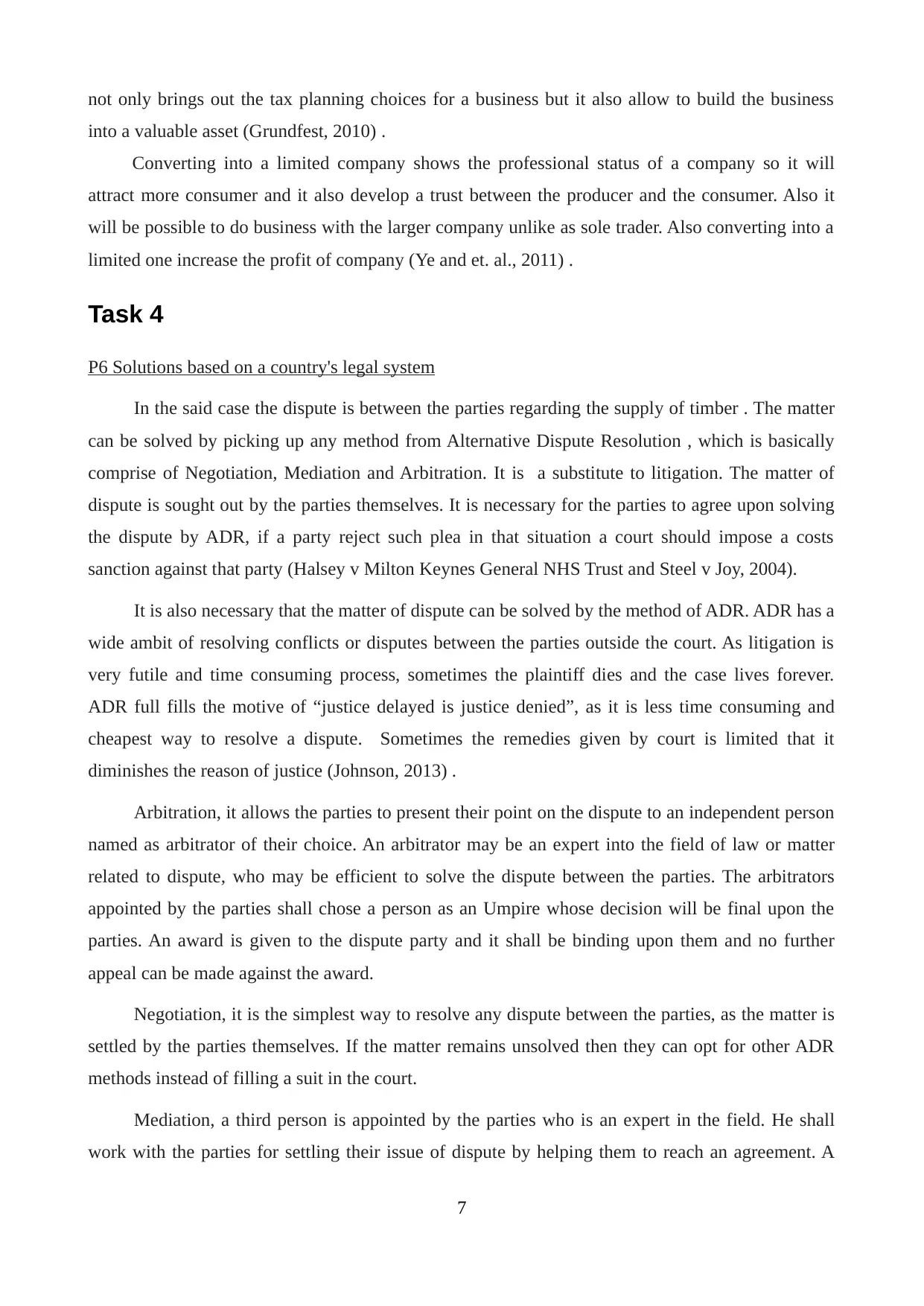
not only brings out the tax planning choices for a business but it also allow to build the business
into a valuable asset (Grundfest, 2010) .
Converting into a limited company shows the professional status of a company so it will
attract more consumer and it also develop a trust between the producer and the consumer. Also it
will be possible to do business with the larger company unlike as sole trader. Also converting into a
limited one increase the profit of company (Ye and et. al., 2011) .
Task 4
P6 Solutions based on a country's legal system
In the said case the dispute is between the parties regarding the supply of timber . The matter
can be solved by picking up any method from Alternative Dispute Resolution , which is basically
comprise of Negotiation, Mediation and Arbitration. It is a substitute to litigation. The matter of
dispute is sought out by the parties themselves. It is necessary for the parties to agree upon solving
the dispute by ADR, if a party reject such plea in that situation a court should impose a costs
sanction against that party (Halsey v Milton Keynes General NHS Trust and Steel v Joy, 2004).
It is also necessary that the matter of dispute can be solved by the method of ADR. ADR has a
wide ambit of resolving conflicts or disputes between the parties outside the court. As litigation is
very futile and time consuming process, sometimes the plaintiff dies and the case lives forever.
ADR full fills the motive of “justice delayed is justice denied”, as it is less time consuming and
cheapest way to resolve a dispute. Sometimes the remedies given by court is limited that it
diminishes the reason of justice (Johnson, 2013) .
Arbitration, it allows the parties to present their point on the dispute to an independent person
named as arbitrator of their choice. An arbitrator may be an expert into the field of law or matter
related to dispute, who may be efficient to solve the dispute between the parties. The arbitrators
appointed by the parties shall chose a person as an Umpire whose decision will be final upon the
parties. An award is given to the dispute party and it shall be binding upon them and no further
appeal can be made against the award.
Negotiation, it is the simplest way to resolve any dispute between the parties, as the matter is
settled by the parties themselves. If the matter remains unsolved then they can opt for other ADR
methods instead of filling a suit in the court.
Mediation, a third person is appointed by the parties who is an expert in the field. He shall
work with the parties for settling their issue of dispute by helping them to reach an agreement. A
7
into a valuable asset (Grundfest, 2010) .
Converting into a limited company shows the professional status of a company so it will
attract more consumer and it also develop a trust between the producer and the consumer. Also it
will be possible to do business with the larger company unlike as sole trader. Also converting into a
limited one increase the profit of company (Ye and et. al., 2011) .
Task 4
P6 Solutions based on a country's legal system
In the said case the dispute is between the parties regarding the supply of timber . The matter
can be solved by picking up any method from Alternative Dispute Resolution , which is basically
comprise of Negotiation, Mediation and Arbitration. It is a substitute to litigation. The matter of
dispute is sought out by the parties themselves. It is necessary for the parties to agree upon solving
the dispute by ADR, if a party reject such plea in that situation a court should impose a costs
sanction against that party (Halsey v Milton Keynes General NHS Trust and Steel v Joy, 2004).
It is also necessary that the matter of dispute can be solved by the method of ADR. ADR has a
wide ambit of resolving conflicts or disputes between the parties outside the court. As litigation is
very futile and time consuming process, sometimes the plaintiff dies and the case lives forever.
ADR full fills the motive of “justice delayed is justice denied”, as it is less time consuming and
cheapest way to resolve a dispute. Sometimes the remedies given by court is limited that it
diminishes the reason of justice (Johnson, 2013) .
Arbitration, it allows the parties to present their point on the dispute to an independent person
named as arbitrator of their choice. An arbitrator may be an expert into the field of law or matter
related to dispute, who may be efficient to solve the dispute between the parties. The arbitrators
appointed by the parties shall chose a person as an Umpire whose decision will be final upon the
parties. An award is given to the dispute party and it shall be binding upon them and no further
appeal can be made against the award.
Negotiation, it is the simplest way to resolve any dispute between the parties, as the matter is
settled by the parties themselves. If the matter remains unsolved then they can opt for other ADR
methods instead of filling a suit in the court.
Mediation, a third person is appointed by the parties who is an expert in the field. He shall
work with the parties for settling their issue of dispute by helping them to reach an agreement. A
7
Paraphrase This Document
Need a fresh take? Get an instant paraphrase of this document with our AI Paraphraser
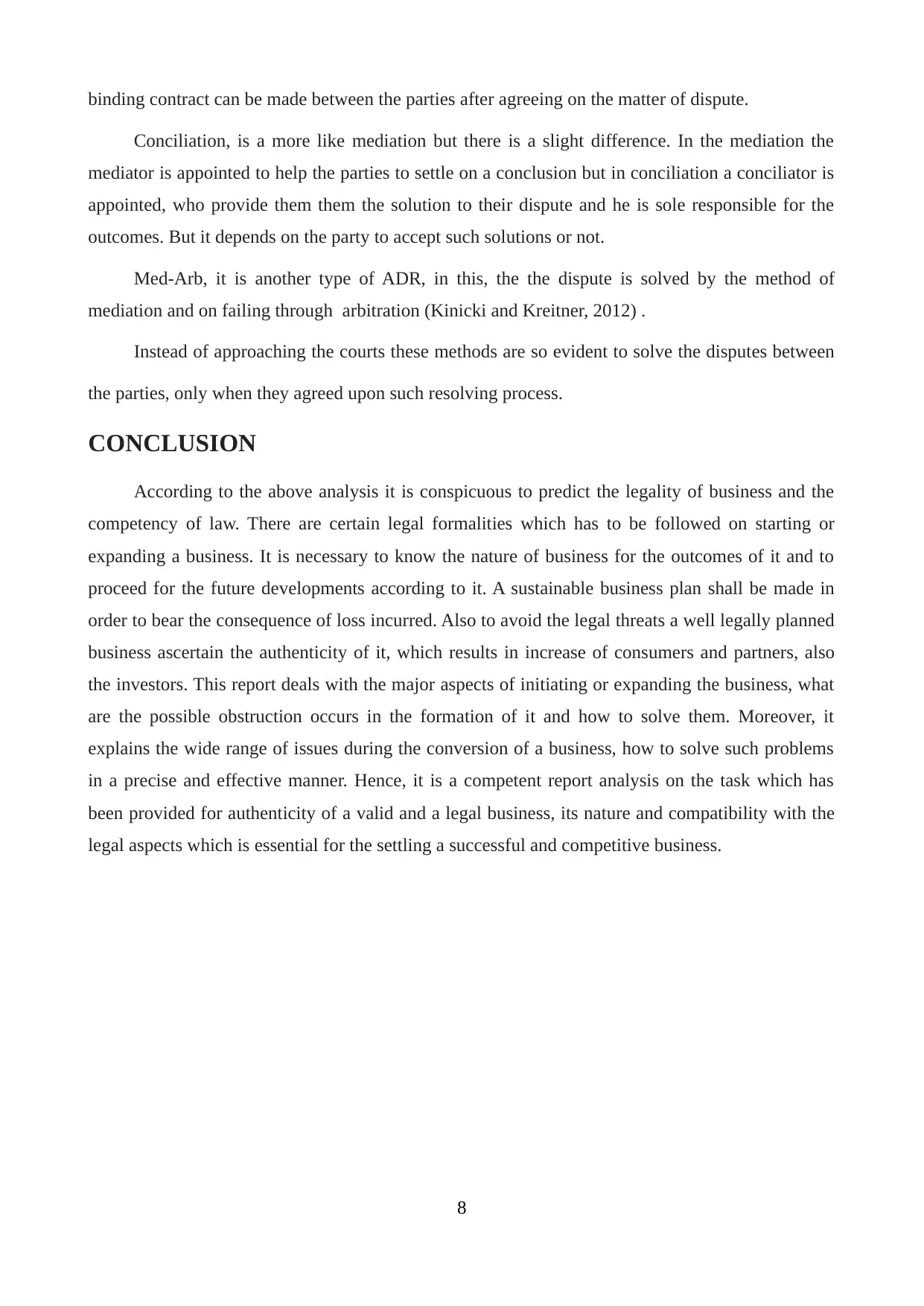
binding contract can be made between the parties after agreeing on the matter of dispute.
Conciliation, is a more like mediation but there is a slight difference. In the mediation the
mediator is appointed to help the parties to settle on a conclusion but in conciliation a conciliator is
appointed, who provide them them the solution to their dispute and he is sole responsible for the
outcomes. But it depends on the party to accept such solutions or not.
Med-Arb, it is another type of ADR, in this, the the dispute is solved by the method of
mediation and on failing through arbitration (Kinicki and Kreitner, 2012) .
Instead of approaching the courts these methods are so evident to solve the disputes between
the parties, only when they agreed upon such resolving process.
CONCLUSION
According to the above analysis it is conspicuous to predict the legality of business and the
competency of law. There are certain legal formalities which has to be followed on starting or
expanding a business. It is necessary to know the nature of business for the outcomes of it and to
proceed for the future developments according to it. A sustainable business plan shall be made in
order to bear the consequence of loss incurred. Also to avoid the legal threats a well legally planned
business ascertain the authenticity of it, which results in increase of consumers and partners, also
the investors. This report deals with the major aspects of initiating or expanding the business, what
are the possible obstruction occurs in the formation of it and how to solve them. Moreover, it
explains the wide range of issues during the conversion of a business, how to solve such problems
in a precise and effective manner. Hence, it is a competent report analysis on the task which has
been provided for authenticity of a valid and a legal business, its nature and compatibility with the
legal aspects which is essential for the settling a successful and competitive business.
8
Conciliation, is a more like mediation but there is a slight difference. In the mediation the
mediator is appointed to help the parties to settle on a conclusion but in conciliation a conciliator is
appointed, who provide them them the solution to their dispute and he is sole responsible for the
outcomes. But it depends on the party to accept such solutions or not.
Med-Arb, it is another type of ADR, in this, the the dispute is solved by the method of
mediation and on failing through arbitration (Kinicki and Kreitner, 2012) .
Instead of approaching the courts these methods are so evident to solve the disputes between
the parties, only when they agreed upon such resolving process.
CONCLUSION
According to the above analysis it is conspicuous to predict the legality of business and the
competency of law. There are certain legal formalities which has to be followed on starting or
expanding a business. It is necessary to know the nature of business for the outcomes of it and to
proceed for the future developments according to it. A sustainable business plan shall be made in
order to bear the consequence of loss incurred. Also to avoid the legal threats a well legally planned
business ascertain the authenticity of it, which results in increase of consumers and partners, also
the investors. This report deals with the major aspects of initiating or expanding the business, what
are the possible obstruction occurs in the formation of it and how to solve them. Moreover, it
explains the wide range of issues during the conversion of a business, how to solve such problems
in a precise and effective manner. Hence, it is a competent report analysis on the task which has
been provided for authenticity of a valid and a legal business, its nature and compatibility with the
legal aspects which is essential for the settling a successful and competitive business.
8
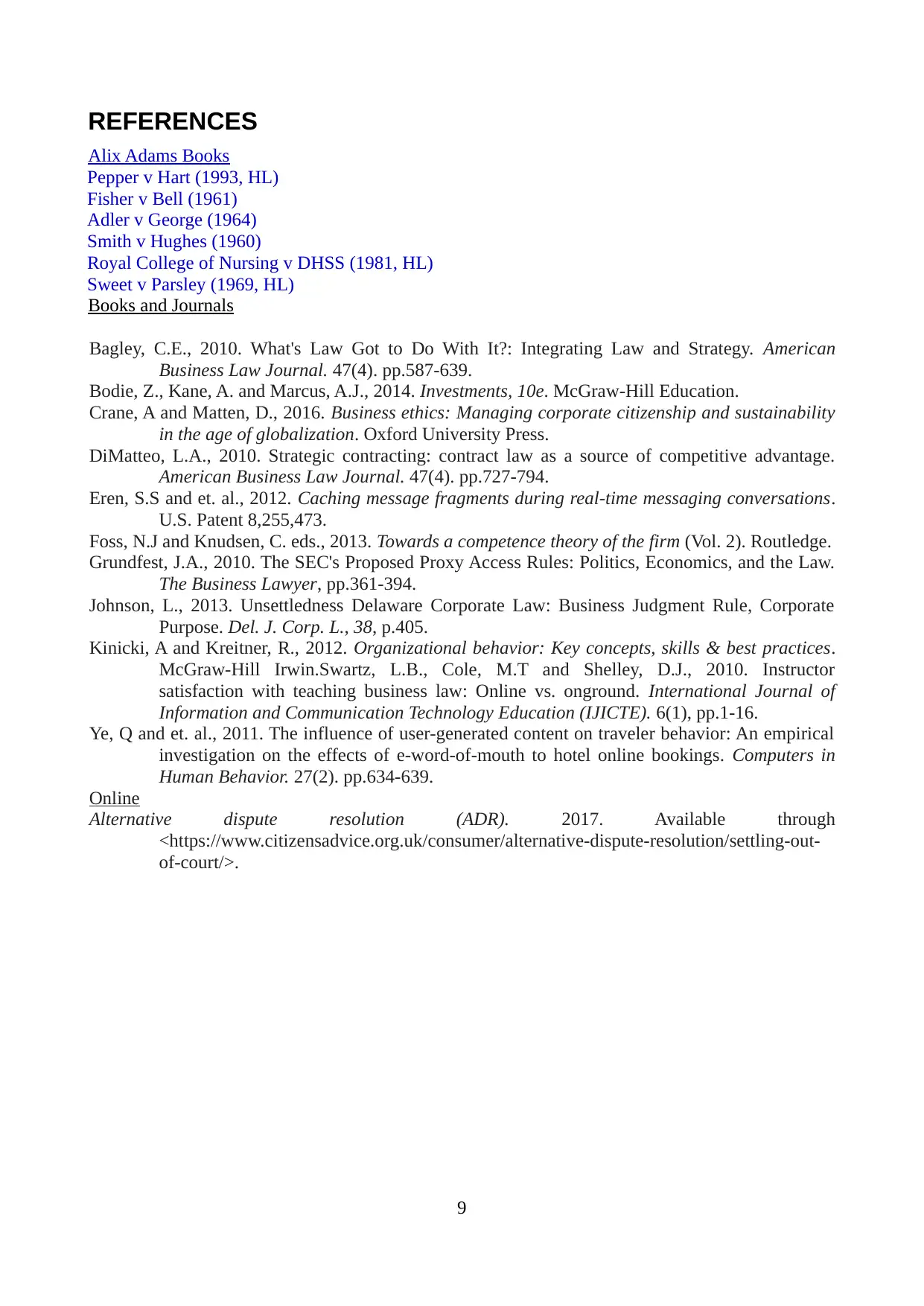
REFERENCES
Alix Adams Books
Pepper v Hart (1993, HL)
Fisher v Bell (1961)
Adler v George (1964)
Smith v Hughes (1960)
Royal College of Nursing v DHSS (1981, HL)
Sweet v Parsley (1969, HL)
Books and Journals
Bagley, C.E., 2010. What's Law Got to Do With It?: Integrating Law and Strategy. American
Business Law Journal. 47(4). pp.587-639.
Bodie, Z., Kane, A. and Marcus, A.J., 2014. Investments, 10e. McGraw-Hill Education.
Crane, A and Matten, D., 2016. Business ethics: Managing corporate citizenship and sustainability
in the age of globalization. Oxford University Press.
DiMatteo, L.A., 2010. Strategic contracting: contract law as a source of competitive advantage.
American Business Law Journal. 47(4). pp.727-794.
Eren, S.S and et. al., 2012. Caching message fragments during real-time messaging conversations.
U.S. Patent 8,255,473.
Foss, N.J and Knudsen, C. eds., 2013. Towards a competence theory of the firm (Vol. 2). Routledge.
Grundfest, J.A., 2010. The SEC's Proposed Proxy Access Rules: Politics, Economics, and the Law.
The Business Lawyer, pp.361-394.
Johnson, L., 2013. Unsettledness Delaware Corporate Law: Business Judgment Rule, Corporate
Purpose. Del. J. Corp. L., 38, p.405.
Kinicki, A and Kreitner, R., 2012. Organizational behavior: Key concepts, skills & best practices.
McGraw-Hill Irwin.Swartz, L.B., Cole, M.T and Shelley, D.J., 2010. Instructor
satisfaction with teaching business law: Online vs. onground. International Journal of
Information and Communication Technology Education (IJICTE). 6(1), pp.1-16.
Ye, Q and et. al., 2011. The influence of user-generated content on traveler behavior: An empirical
investigation on the effects of e-word-of-mouth to hotel online bookings. Computers in
Human Behavior. 27(2). pp.634-639.
Online
Alternative dispute resolution (ADR). 2017. Available through
<https://www.citizensadvice.org.uk/consumer/alternative-dispute-resolution/settling-out-
of-court/>.
9
Alix Adams Books
Pepper v Hart (1993, HL)
Fisher v Bell (1961)
Adler v George (1964)
Smith v Hughes (1960)
Royal College of Nursing v DHSS (1981, HL)
Sweet v Parsley (1969, HL)
Books and Journals
Bagley, C.E., 2010. What's Law Got to Do With It?: Integrating Law and Strategy. American
Business Law Journal. 47(4). pp.587-639.
Bodie, Z., Kane, A. and Marcus, A.J., 2014. Investments, 10e. McGraw-Hill Education.
Crane, A and Matten, D., 2016. Business ethics: Managing corporate citizenship and sustainability
in the age of globalization. Oxford University Press.
DiMatteo, L.A., 2010. Strategic contracting: contract law as a source of competitive advantage.
American Business Law Journal. 47(4). pp.727-794.
Eren, S.S and et. al., 2012. Caching message fragments during real-time messaging conversations.
U.S. Patent 8,255,473.
Foss, N.J and Knudsen, C. eds., 2013. Towards a competence theory of the firm (Vol. 2). Routledge.
Grundfest, J.A., 2010. The SEC's Proposed Proxy Access Rules: Politics, Economics, and the Law.
The Business Lawyer, pp.361-394.
Johnson, L., 2013. Unsettledness Delaware Corporate Law: Business Judgment Rule, Corporate
Purpose. Del. J. Corp. L., 38, p.405.
Kinicki, A and Kreitner, R., 2012. Organizational behavior: Key concepts, skills & best practices.
McGraw-Hill Irwin.Swartz, L.B., Cole, M.T and Shelley, D.J., 2010. Instructor
satisfaction with teaching business law: Online vs. onground. International Journal of
Information and Communication Technology Education (IJICTE). 6(1), pp.1-16.
Ye, Q and et. al., 2011. The influence of user-generated content on traveler behavior: An empirical
investigation on the effects of e-word-of-mouth to hotel online bookings. Computers in
Human Behavior. 27(2). pp.634-639.
Online
Alternative dispute resolution (ADR). 2017. Available through
<https://www.citizensadvice.org.uk/consumer/alternative-dispute-resolution/settling-out-
of-court/>.
9
⊘ This is a preview!⊘
Do you want full access?
Subscribe today to unlock all pages.

Trusted by 1+ million students worldwide
1 out of 9
Related Documents
Your All-in-One AI-Powered Toolkit for Academic Success.
+13062052269
info@desklib.com
Available 24*7 on WhatsApp / Email
![[object Object]](/_next/static/media/star-bottom.7253800d.svg)
Unlock your academic potential
Copyright © 2020–2025 A2Z Services. All Rights Reserved. Developed and managed by ZUCOL.





